There is a distinct allure to the old buildings of north Kolkata. From the spacious courtyards to the extensive balconies, and the vast windows to the intimate corners where time and space seem to warp into one, decadent architecture in this part of the city has its own delight. At the same time, the story of this decadence is inseparably linked to decrepitude, decay and decline. Old buildings in north Kolkata are dying, and so is the culture contained within.
“I want to start a conversation on how to restore old spaces in the city, how to create a balance between the old and the new, so that the heritage of Kolkata can be retained,” said Iftekhar Ahsan, founder of Calcutta Walks and general manager of Calcutta Bungalow. Iftekhar was talking to a pool of 30 students from the School of Architecture at Salt Lake’s Techno India University, before guiding them on a walking tour of select spaces that require restoration, on May 14.
‘The whole point of the exercise was to recreate the glories of an era gone by’
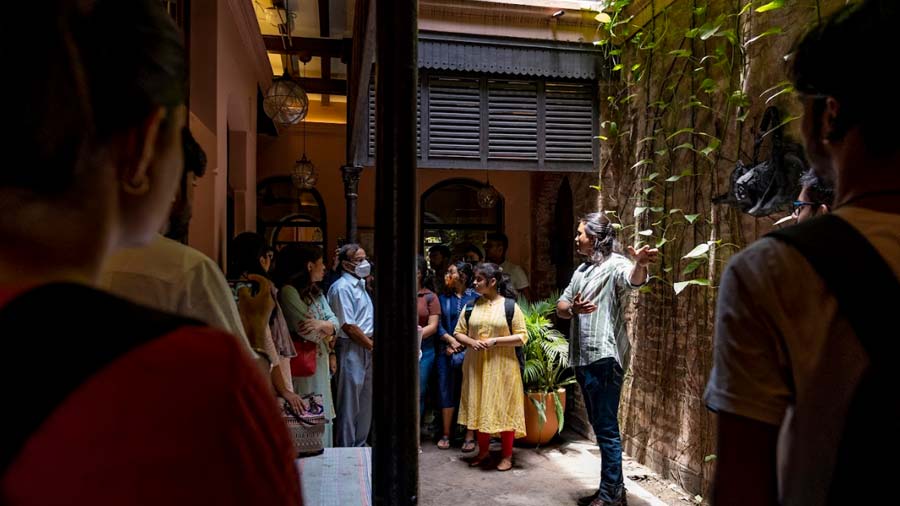
Iftekhar explained how he and his team helped restore Calcutta Bungalow from a 1920s townhouse into a heritage boutique hotel
The tour got underway at noon at Calcutta Bungalow, a 1920s townhouse Iftekhar helped convert into a heritage bed-and-breakfast lodge, which opened in its new avatar in 2018. Once the budding architects, accompanied by faculty members, had assembled at Calcutta Bungalow on Fariapukur’s Radha Kanta Jew Street, Iftekhar explained how he and his associates went about transforming the space in front of them.
“We bought and upcycled as many old and reclaimed items as possible, since the whole point of the exercise was to recreate the glories of an era gone by. Almost all our wood and iron were taken from buildings that had met their demise in other parts of Kolkata. For instance, we bought tons of khorkhoris, or louvred windows, and re-purposed them as installations in the courtyard and bedside tables,” said Iftekhar.
Old emotions with new facilities

From a zamindari household to a space of democratic indulgence, Calcutta Bungalow has enjoyed quite the transformation
Initially built in the classical mould, instead of the art deco style that gained popularity during the 1920s and ’30s, Calcutta Bungalow used to be a zamindari household, but its present vibe is that of refinement accessible to all. Many of the students who marvelled at the intricacy of its architectural splendour, agreed. “It’s a combination of old emotions with new facilities, as if history has been preserved for today’s generation to understand and relate to,” observed Sohini Chakraborty. For one of her peers, Anushka Sinha, what stood out about the place was, “the understated elegance, best captured by the copper bathtub in one of the washrooms.”
After reaching the terrace of Calcutta Bungalow, Iftekhar narrated how vastu and adjacent buildings had been taken into consideration during the reconstruction. “We were careful in choosing a space that has no high-rises in its immediate vicinity, which is why you will always experience a gentle breeze on the terrace,” said Iftekhar.
Kolkata’s version of The Best Exotic Marigold Hotel

Mitra Bari’s divided property makes it trickier to restore, although neither Iftekhar nor his mentees for the day seemed deterred
Having mesmerised the students with the thought behind Calcutta Bungalow’s restoration, it was time to head out into the scorching sun, with Mitra Bari on Hatibagan’s Shyampukur Street selected as the first port of call.
Developed at some point in the late 1880s, Mitra Bari is presently a partitioned property, one half of which is up for restoration. According to Iftekhar, the space is conducive to create, “Kolkata’s version of The Best Exotic Marigold Hotel, where active seniors can come together to build a community.” As usual with makeovers, it is easier said than done. “The biggest challenge is to find owners open to restoration. Once the will is there to restore the family legacy, to save their home and give it a new lease of life, the rest can all be worked out,” said Iftekhar.
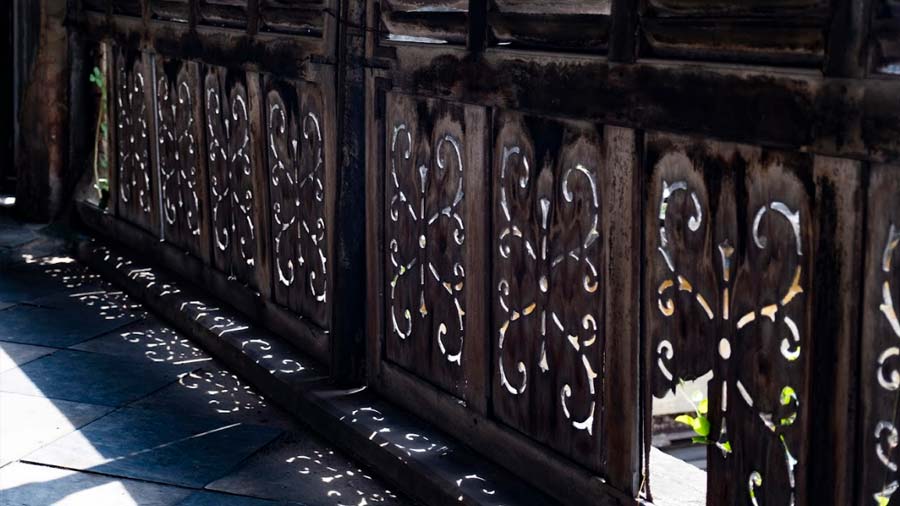
Mitra Bari is a classic example of the paradox of ageing architecture
Wandering through the four floors of Mitra Bari, the Techno India students could feel the paradox of the building’s ageing architecture in real time. “There is so much beauty in this place, but there is also a lot of ruin. The first thing I’d do if I were to take this up as a project would be to replace the bricks and conceive of the space as a residential property that can be re-created without the partitioned boundaries being a hindrance,” said Shirshendu Paul.
The different types of architectural heritage
Once all the students had taken a tour of the house, Iftekhar pointed out how the thick walls and the high ceilings of the building kept it cool even during the peak of summer, before proceeding to explain how the restoration, estimated to cost Rs 10 crore, would unfold step-by-step: “The first phase [in the restoration] would be to prevent the building from further destruction, strengthen it and get it up and ready for the next 100 years. Then there would be the need for fresh plumbing, electric wiring and retrofitting of air conditioners, lifts, ramps, lights and fans. Finally, it’d be about deciding how to best use the place.”

The mid-May heat did little to spoil the enthusiasm of the students from Techno India
As the tour moved on from Mitra Bari towards its next destination, Shreya Das, part of the architecture faculty, characterised the nature of the course at Techno India: “The architecture department started in 2013. Students undertake a five year programme during which they consolidate their theoretical understanding besides hitting the ground for practical, applied work. Tours and expeditions that further their knowledge and experience with buildings are organised frequently, although the pandemic put a temporary halt to such activities for a couple of years.”
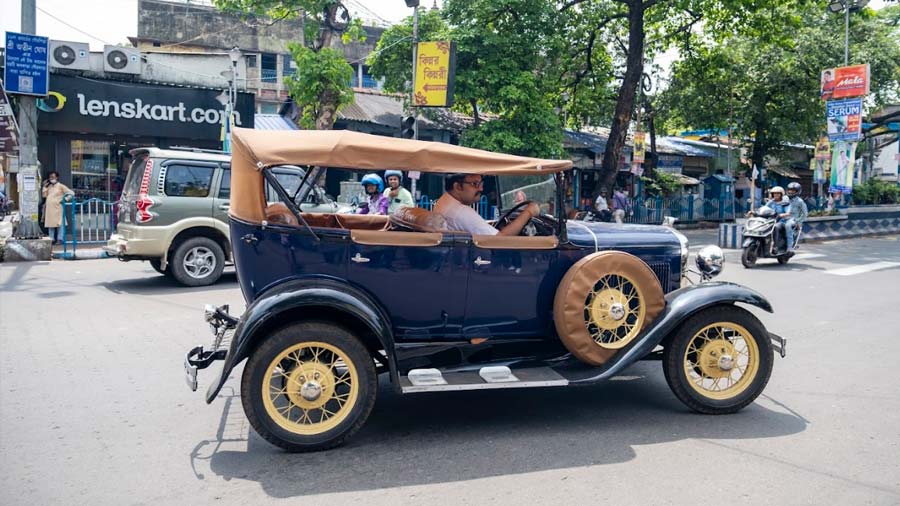
Old buildings were not the only vintage things spotted on the walking tour!
In Das’s opinion, architecture involves an “interplay between emotions and property” and a competent architect must know how to respect “the different types of architectural heritage that a place evokes, from its natural essence to its built reality to the cultural legacy that is stored inside.”
The library in a lull
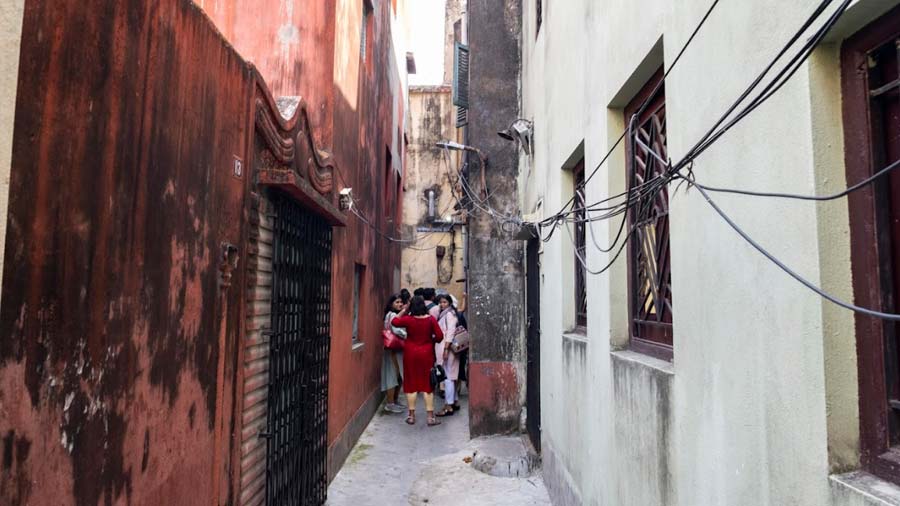
Nimble footwork was required to navigate the narrow lanes in Darjipara, en route to the Chaitanya Library
Having walked close to five kilometres, largely due to a circuitous route that covered some of the narrowest lanes in the city on Masjid Bari Street or Darjipara, Iftekhar and his proteges for the day reached the Chaitanya Library on Sovabazar’s Abhedananda Road, just as the clock struck two.
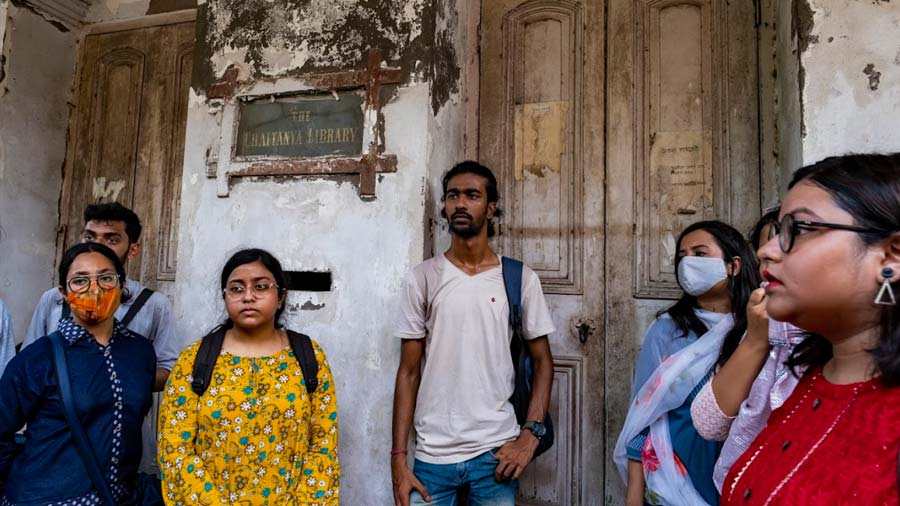
The Chaitanya Library was the first registered society of its kind in undivided Bengal
Set up by Gaur Hari Sen and Kunj Behari Dutta, and inaugurated in 1889 by Rabindranath Tagore (among others), the library was the first registered society of its kind in undivided Bengal, and is a stone’s throw away from Minerva Theatre, whose restorative fortunes have been far greater than those of the dilapidated atheneum.
In harmony with most of the colonial architecture in Kolkata, the Chaitanya Library comprises French or Venetian windows, wooden balustrades and a fair few ventilators. Its white facade, no longer as impeccable as in the preceding centuries, is crumbling every day, as if exhausted by its own ennui. Once a lecture venue for Nobel laureates like Tagore and C.V. Raman, the library is in urgent need of a resurrection, with its termite-infested books, just like its infrastructure, living on borrowed time.

A facelift for the library could see the addition of a cafeteria, a seminar hall or even a hostel for artists and scholars
“What are the ways in which we can turn this library around?” asked Iftekhar, who thinks that a sum of Rs 5 crores is what the library would require for a thorough rejuvenation. After some planning and pondering, Devjyoti Pramanik, Dwijottama Bhattacharya and Purnima Singh came up with a series of suggestions on behalf of the students – from creating an art studio to facilitating seminars to introducing a cafeteria that matched the mood of the milieu.
For his part, Iftekhar chimed in with a couple of ideas of his own: “I’d like this place to have a hostel to accommodate artists and scholars. I want it to be a repository of creativity, a place where people can come and think and immerse themselves in cerebral pursuits. But in doing so, we must maintain a democratic process. Listen to the locals, the city folk, the library trustees as well as the experts, and only then arrive at something that works.”
On their way out of the Chaitanya Library, quite a few of the students went through the notes they had accumulated during the course of the walk. At the culmination of an enriching tour, there was a sense of satisfaction after an afternoon of productive learning, but the greater feeling was that of curiosity. “We must find out more about the city’s heritage and everything it entails. It’s not enough to know how to build; we must also know how to conserve,” said Deblina Banik, while glancing at her notebook. “For us, experiences like this are vital to realising what Kolkata needs,” she added.

